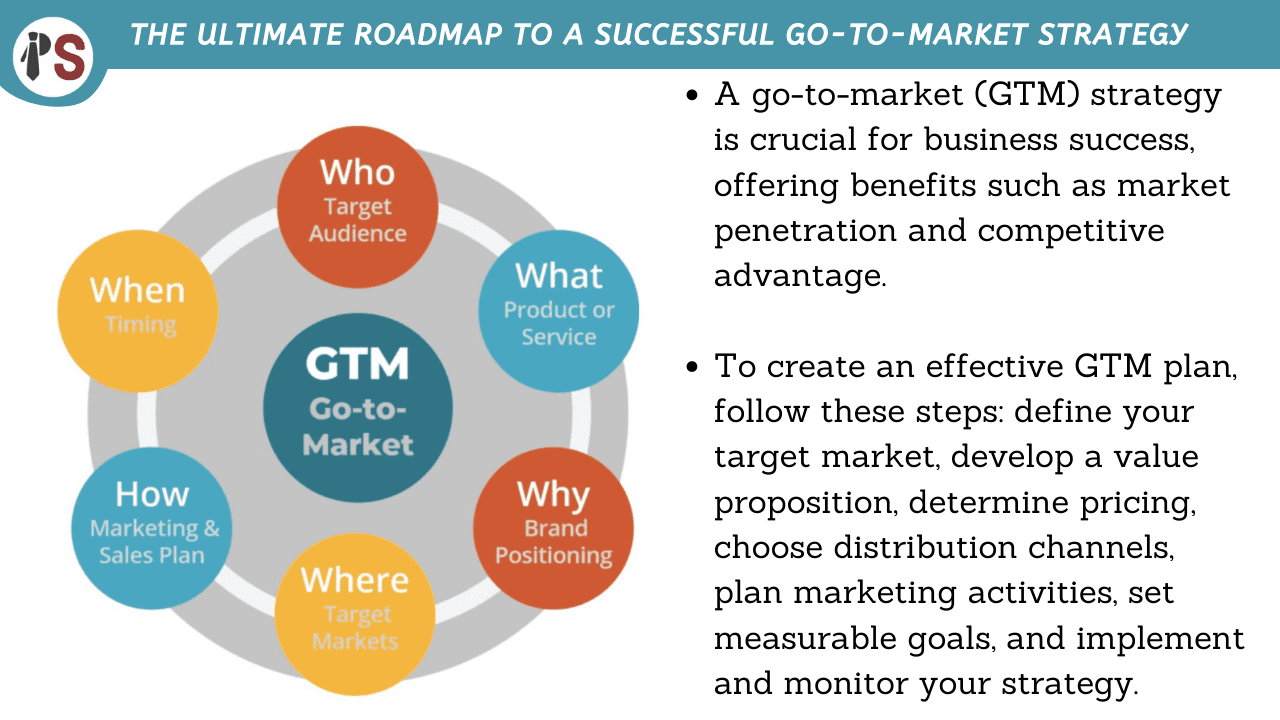
In today's competitive business landscape, having a well-designed go-to-market (GTM) strategy is critical for achieving success and standing out from the crowd. This blog post will provide an in-depth understanding of GTM strategy, its importance, and the steps involved in creating an effective GTM plan for your business.
A go-to-market strategy is a comprehensive action plan that outlines how a company will successfully launch and promote its products or services to its target customers. It encompasses every aspect of the process, from product development and positioning to pricing, distribution channels, and marketing efforts. The primary goal of a GTM strategy is to ensure that your offerings reach the right customers, at the right time, and through the right channels, ultimately driving customer engagement and sales.
A well-crafted GTM strategy offers numerous benefits for businesses:
Market Penetration: It helps businesses penetrate new markets or expand their presence in existing ones, ensuring that their products or services reach the right audience.
Competitive Advantage: A GTM strategy enables businesses to differentiate themselves from competitors, identify unique selling propositions, and establish a strong market position.
Customer Engagement: By focusing on the needs and preferences of target customers, a GTM strategy helps businesses create offerings that resonate with their audience and drive customer engagement.
Reduced Risk: A thorough GTM strategy helps businesses identify potential challenges and risks in advance, allowing them to develop appropriate mitigation strategies.
Improved Efficiency: A well-planned GTM strategy streamlines the launch process, reducing time-to-market and ensuring efficient resource allocation.
To create a successful GTM strategy, you must first identify and define your target market. This involves conducting market research to understand the demographics, psychographics, and preferences of your potential customers. Segmenting your target audience based on these factors will allow you to tailor your products, services, and marketing efforts to their unique needs and preferences.
A value proposition is a clear statement that communicates the unique benefits and advantages your product or service offers to customers. To create a compelling value proposition, identify the key features and benefits of your offering, and explain how they address your target customers' pain points or needs. Your value proposition should clearly differentiate your product or service from competitors and demonstrate why customers should choose your offering over others.
Pricing plays a crucial role in your GTM strategy, as it can significantly impact customer perception and purchasing decisions. To develop an effective pricing strategy, consider factors such as production costs, market demand, competitor pricing, and your target customers' willingness to pay. Select a pricing model that aligns with your business goals and value proposition, while also remaining competitive in the market.
Selecting the right distribution channels is essential for ensuring that your products or services reach your target audience effectively. Consider both direct and indirect channels, such as online platforms, retail stores, wholesalers, or third-party resellers, and select the ones that align with your target market's preferences and purchasing habits.
Your marketing and promotional efforts play a critical role in raising awareness about your offerings and driving customer engagement. Develop a comprehensive marketing plan that includes both online and offline channels, such as social media, email marketing, content marketing, search engine optimization (SEO), events, and traditional advertising. Ensure that your marketing messages are consistent across all channels and resonate with your target audience.
To track the success of your GTM strategy, set measurable goals and objectives that align with your business priorities. These goals may include metrics such as market share, revenue, customer acquisition, or brand awareness. Establishing clear benchmarks will enable you to monitor your progress and make data-driven decisions to optimize your GTM strategy.
Once you have developed your GTM strategy, it's time to put it into action. Ensure that all teams and stakeholders are aligned and understand their responsibilities in executing the plan. As you implement your GTM strategy, monitor your progress by tracking your key performance indicators (KPIs) and adjusting your approach as needed based on the results.
Creating a comprehensive go-to-market strategy is crucial for any business seeking to launch new products or services, enter new markets, or expand its customer base. By following the steps outlined above, you can develop an effective GTM strategy that drives customer engagement, differentiates your offerings from competitors, and ultimately contributes to your business's long-term success. Remember, a well-planned GTM strategy is a critical factor in achieving your goals and staying ahead in today's competitive business environment.
At Professional Saathi, we offer a range of business consultancy services that help businesses improve their performance, achieve growth, and overcome challenges.
Copyright 2026 © Created By KTPG PROFESSIONAL SAATHI CORPORATE CONSULTANT PRIVATE LIMITED, All Rights Reserved.
Leave Your Comment